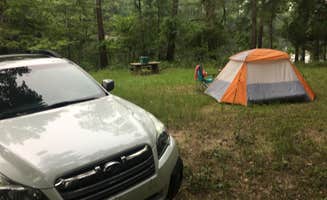Tent camping sites near Pineland, Texas range across a 35-mile radius encompassing both national forest lands and wildlife management areas. The region sits within the East Texas Piney Woods ecosystem at elevations between 200-400 feet. Winter camping temperatures typically range from 35-60°F while fall remains the most popular season for tent camping due to decreased humidity and moderate temperatures in the 60-75°F range.
What to do
Fishing access: Angelina (Sam Rayburn Reservoir Area) offers multiple shoreline fishing spots within walking distance of tent camping areas. A camper notes, "The lake was fun to kayak on. It was raining so not many people were there. Spiders galore here, fair warning."
ATV trails: Po-Man Outdoor Collective R&R maintains primitive trail systems for ATV riders who camp overnight. According to a reviewer, "Bring your fishing gear, ATVs & horses! This property is maintained much like public lands, no campground feel here."
Wildlife observation: The tent camping areas contain observation points for native East Texas wildlife including white-tailed deer, various woodpeckers, and migratory songbirds. Most sites require quiet hours from 10pm-6am to avoid disturbing wildlife patterns.
What campers like
Natural water features: Bouton Lake Campground provides tent sites adjacent to a small pond suitable for fishing. A camper describes it as a "Nice, small dispersed campground with several picnic tables, with room for more parking w/o tables. On a small pretty pond. Open field, large pines."
Uncrowded experiences: Weekday camping at most Pineland area tent sites sees occupancy rates under 30%, particularly during spring and fall. Most primitive sites require at least 50-100 feet between campsites, providing natural sound barriers.
Basic facilities: Alazan Bayou offers developed tent sites with concrete foundations. A visitor reports, "At least 14 sites with picnic tables on concrete slabs. Fire rings and Lantern poles. Very well kept and mowed. There is a loafing barn for horses."
What you should know
Permit requirements: Texas Parks Limited Use Permits ($12 annually) are required for camping at wildlife management areas. One camper explains about Alazan Bayou: "You need a Texas parks Limited use permit. It costs as little as $12 a year. If you want to fish or hunt the price goes up a little. Can be used to stay at any National Forest or Wild Management area."
Road conditions: Access to several tent camping areas requires travel on unpaved forest service roads. A visitor to Bouton Lake commented, "It was a bit of a drive on a dirt road but the road wasn't too bad. There were a couple of sites along the lake with picnic tables."
Water availability: Most tent sites near Pineland require campers to bring their own water supply. Only Po-Man Outdoor Collective R&R provides drinking water access at tent sites, along with restroom facilities.
Tips for camping with families
Shower facilities: For families needing shower facilities, Po-Man Outdoor Collective R&R maintains basic shower stations accessible to tent campers. The management approach resembles public lands but with added amenities uncommon in primitive sites.
Space for activities: Harvey Creek Park provides open field areas near tent sites suitable for family games while maintaining picnic table access. Most sites accommodate 1-2 family-sized tents with adequate distance between neighboring sites.
Weather considerations: Summer temperatures regularly exceed 90°F with high humidity, making spring and fall preferable for family camping. March-May and September-November typically offer more comfortable overnight temperatures with lower precipitation.
Tips from RVers
Tent camper adaptations: While primarily designed for RVs, Bluffview Park offers several tent-suitable sites with electric hookup access. These sites provide tent campers access to power for air mattress inflation, device charging, and small appliances.
Hybrid camping options: Tent campers seeking additional amenities can utilize select RV areas that offer water hookups usable with standard garden hose connections. These access points typically require 50-100 foot hoses to reach tent sites positioned away from RV pads.
Noise considerations: Tent campers should position at least 200 yards from generator-permitted RV zones to minimize nighttime noise disruption. The eastern sections of most combined RV/tent campgrounds typically offer greater separation and natural sound barriers.


